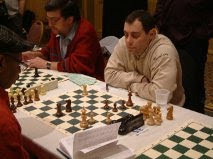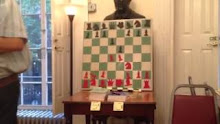NM Jim West - GM Mark Taimanov
1.e4 c5 2.Nf3 e6 3.d4 cxd4 4.Nxd4 Nc6 5.Nb5 d6 6.Bf4
This was Fischer's favorite weapon against the Taimanov variation, and he used it to beat Taimanov in their 1971 candidates match. But it was played as early as 1858 by Paul Morphy against Adolf Anderssen. That game concluded brilliantly: 6...e5 7.Be3 f5 8.N1c3 f4 9.Nd5 fxe3 10.Nbc7+ Kf7 11.Qf3+ Nf6 12.Bc4 Nd4 13.Nxf6+ d5 14.Bxd5+ Kg6 15.Qh5+ Kxf6 16.fxe3 Nxc2+ 17.Ke2, Black resigns.
Against Fischer in one game, Taimanov played 7...Nf6 8.Bg5 Be6 9.N1c3 and only then played 9...a6, but Taimanov probably judged over the board that I was prepared for this main line. Therefore, he chose a lesser known continuation. Already I was in unfamiliar territory.
8.N5c3
Actually, the awkward-looking 8.N5a3 may be better. The game Fischer-Reshevsky, Buenos Aires 1960 proceeded with 8...b5 9.c4 b4 10.Nc2 Nf6 11.Be2 Be7 12.O-O O-O 13.Nd2 Rb8 14.Re1 Be6 15.f3 Nd7 with an eventual draw.
8...Nf6 9.Bg5
Now this move is not strong, since the threatened capture at f6 will not cause doubled f-pawns for Black. It would have been correct to play 9.Na3, as in Fischer-Pachman from the same Buenos Aires event which continued with 9...b5 10.Nd5 Nxd5 11.exd5 Ne7 12.c4 Nf5 13.Bd2 Be7 14.cxb5 Bf6 15.Be2 e4 16.b6 O-O 17.Nc4 Bd4 18.O-O Bxb6 19.Nxb6 Qxb6 20.Bc3 Bb7 21.Bc4 Rac8 22.b3 Ne3 23.Bd4 Nxd1 24.Bxb6 Nc3, draw.
9...Be7 10.Nd2 Bg4
During the post-mortem analysis, Taimanov (who speaks little English) clenched his fist to emphasize the strength of this move. It is better than the immediate 10...Be6 because 11.f3 will leave White vulnerable to ...Qb6+ and ...Qxb2 after castling.
11.f3 Be6 12.Bc4 O-O 13.Bxf6 Bxf6 14.Nd5 Bg5 15.O-O Rc8"Black better" was how Taimanov evaluated this position after the game, and I wasn't about to contest his opinion. After all, nine of the ten chapters in ECO on this line were written by him. So he should know!
16.Kh1
Now White must lose a valuable tempo. (See the comments after Black's 10th move.)
16...b5 17.Bb3 Na5 18.c3 g6
Now I decided to mix things up tactically, hoping to confuse the issue. My strategy nearly worked.
19.f4 Bxd5 20.fxg4 Nxb3 21.axb3 Bb7!
The bishop is ideally placed to harass the white king while protecting the a-pawn.
22.Rf6 d5 23.Nf3 Re8 24.exd5 e4 25.Ng1 Re5
Later Taimanov suggested 26...Qxd5 27.Qxd5 Bxd5 28.Raxa6 Bxb3 with clear advantage for Black.
26.Qg4 Rxd5?! 27.Qxe4!
He overlooked this capture. Now I began to have real hopes of swindling a draw. The trick is that 27...Rxg5? 28.Qxb7 Qxf6 leaves the rook on c8 hanging.
27...Rc7 28.Qf4 Rd2 29.Nf3 Rxb2 30.Rd6 Rd7 31.Rxd7 Qxd7 32.Re1!
I saw visions of 32...Rxb3 33.Qb8+ Bc8 34.Nd2 Rxc3 35.Ne4 Rc6 36.Nf6+ Rxf6 37.gxf6 with 38.Rc1 staring Black in the face. But my opponent's next move put an abrupt stop to this fantasy variation.
32...Qd8!
Afterwards, Taimanov praised this move highly. Now the truth of the position is evident. Although material is even, the black rook controls the vital seventh rank and the black bishop rakes the long diagonal. Meanwhile, White's rook and knight can assume only defensive positions.
33.b4 Rc2 34.Qe3
This makes things easy for Black. 34.Qe5 would be a tougher nut to crack. In the post-mortem, Taimanov said he would have met this move with 34...Qd5 35.Qxd5 Bxd5 36.Re3 Rc1+ 37.Ng1 Rf1 (threatening 38...Rf5) 38.h3 Rf5 39.Rg3 Kf8 40.Nf3 Bxf3! 41.gxf3 Rf4 and 42...Rc4 wins. But in this line, 38.Re5 was a better try.
34...Bxf3! 35.Qxf3
Worse is 35.gxf3 Qc7!
35...Qxg5 36.Rf1 Kh8! 37.g3 Qe7
Now rather than postponing the inevitable in a lost rook endgame with 38.Qxf7 Qxf7 39.Rxf7 Rxc3, I elected to keep the queens on the board.
38.Qc6 Kg7 39.Qd5 f6 40.Qc6 h5 41.Rd1 Kh6 42.Qf3 Qe5 43.Rf1 f5 44.Qc6 Qe2, 0-1.
And I thought Taimanov had retired from chess!
*{This article originally appeared in Atlantic Chess News in 1991}




























